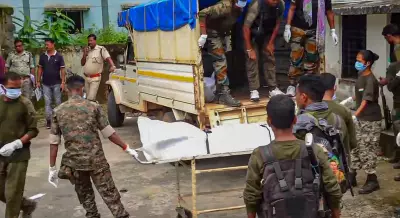Politics
3 Naxalites, Including Woman, Killed in Sukma Encounter with Security Forces
A woman among three Naxalites was killed in an encounter with security forces in Chhattisgarh's Sukma district on December 18. Police confirm the operation was based on specific intelligence.
Business
IBPS SO Mains Scorecard 2025 Released: Download Link, Steps, and Interview Details
IBPS SO Mains scorecard 2025 is now available for download. Candidates can check their marks for CRP SPL-XV using registration details. Last date to download is December 24, 2025.
World
Indian Delivery Worker Dies in UAE Wall Collapse Amid Heavy Rain
An Indian delivery worker, Abdul Gafoor, died in Sharjah after a wall collapsed on him during heavy rain. The incident highlights risks for migrant workers in extreme weather. Read more.
Entertainment
Allu Arjun Reacts to Brother Sirish's Ad with Rohit Sharma: 'Proud & Happy'
Tollywood superstar Allu Arjun expressed pride and surprise after seeing his brother Allu Sirish in a new advertisement with cricket icon Rohit Sharma. Read his heartfelt reaction and fan responses.
Sports
Lifestyle
Health
Viral Kickboxing Video: Army Vet's Fitness Stuns Internet
A 61-year-old retired Lieutenant Colonel's intense kickboxing routine goes viral on X, drawing playful Mahatma Gandhi comparisons. Discover the story behind the fit veteran's discipline.
Diabetes Cases Projected to Reach 900 Million by 2050
New projections warn diabetes cases could hit 900 million globally by 2050, driven by modern lifestyles. Learn the causes, impacts, and prevention strategies to combat this silent pandemic.
Delhi roads see less traffic after GRAP-4 implementation
Delhi government reports a significant reduction in vehicular movement following the imposition of GRAP-4 anti-pollution measures. Read the full impact assessment here.
Six Kids Get HIV from Tainted Blood in Satna; 3 Suspended
Madhya Pradesh govt suspends three, including blood bank in-charge, after six children contract HIV via transfusion in Satna. Read the shocking details and official action.
David Caprio's Skin Cancer Scare: A Vital Warning
David Caprio, son of Judge Frank Caprio, shares a chilling skin cancer biopsy story. Learn about skin cancer risks, types like melanoma, and crucial prevention tips to protect yourself and family.
Technology
Get Updates
Subscribe to our newsletter to receive the latest updates in your inbox!
We hate spammers and never send spam










































